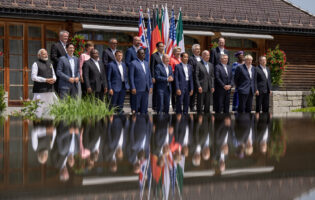Sustainable Urban and Regional Transportation Systems: Financing and Planning
On Friday, June 15, 2012, the American-German Institute hosted a conference on “Sustainable Urban and Regional Transportation Systems: Financing and Planning” generously supported by the Daimler-Fonds im Stifterverband für die Deutsche Wissenschaft.
The first panel focused on planning aspects of sustainable transportation. In their presentations, the panelists sought to address the following queries: Why is transatlantic learning relevant? How does planning work? How is transportation and land use coordinated? With the mutual economic strength of Germany and the United States, high levels of car ownership, strong federal and local governments, and the importance of automobile manufacturing, the panelists reaffirmed the relevancy of transatlantic learning with regard to transportation. Despite these similarities, the German government employs markedly more regulation in order to reduce demand for automobiles, and thus, compel its citizens to use public transportation. With heavy taxes on gasoline and restrictions in land development, the environment of many German cities favors extensive public transportation systems. Conversely, in the United States investment in transportation infrastructure has remained relatively constant for nearly four decades. All panel participants emphasized the importance of proper marketing of transportation policies. In the discussion, Arlington arose as an example of a city that has successfully promoted and developed its public transportation system. While 88 percent of families living in Arlington own a car, often these automobiles sit in garages during the week. Since 1996, mass transit in Arlington has grown by 40 percent, making the city an advantageous location to start businesses. The panelists reported that public policy initiatives created the most pronounced impact on workers’ commutes.
The second panel on “Financing Aspects of Urban and Regional Transportation” addressed challenges to and alternative methods of publicly and/or privately financing energy-efficient urban and regional transportation systems. Introduced in the context of three prolonged challenges for financing transportation projects, including a trend of decreasing traditional tax revenue, the need for linking transportation and land use, and an opportunity for capitalizing on the ongoing technological revolution, this panel adopted a wide perspective from local to national. Furthermore, highlighting projects from various innovative models, speakers addressed their respective experience from progress on projects or in academic theory with specific consideration of funding challenges.
Defining the existing problem in funding in the United States both at a micro and macro level, the continuing decrease in public funds, particularly from the federal government, necessitates alternative financing structures. Speaking to this effect, one panelist detailed the progress of the Dulles Corridor Metrorail Project, which is independently estimated to cost $2.7 billion. Although Virginia is the first state to use a public-private partnership (PPP), this project has received only state and federal funding commitments and is working to reduce cost by shifting costs to counties and seeking further state funds. Meanwhile, tacitly addressing many of the struggles this project encounters, another speaker supported the benefits of infrastructure banks, which are initially capitalized by the government and can issue bonds, take on debt at six-to-one, engage in credit enhancement, and give grants at up to 20 percent of its capitalization to support transit projects statewide. In addition to the fact that they do not generate revenue, the speaker also warned that these banks, which thirty-five states currently have, need to evaluate projects carefully, diversify geographically, and predict demand.
Throughout the panel, many speakers pointed to the notion that existing technology has the capacity to meet transportation demand within the current infrastructure both cost-efficiently and sustainably. To this end, one speaker noted the immediate necessity of Department of Defense facilities, which are suffering an extreme shortfall in parking infrastructure, to implement a ridesharing program and negative incentives for single occupant vehicles. Sharing many similar concerns, such as safety for riders and passengers, coverage to and from locations, and competition with taxi and public transit, another speaker detailed the historical transition of rideshare methods and outlined how Smartphone applications and other technology can ensure safety and up-to-the-second availability to a wide variety of destinations.
One speaker highlighted German practices to overcome similar challenges as the United States. Although the German general funding structure is 10 percent farebox revenue and primarily Bundesland (state) and federal level subsidies, the panelist noted Germany’s law requiring trucks to pay road charges at 12 euro cents per kilometer and generating €4.9 billion as a PPP with Deutsche Bahn AG and other firms. The Stuttgart region emphasizes the transition to electric transportation to avoid smog buildup in the bowl-shaped city of Stuttgart and has implemented a five-year competition among municipalities to use more common and connected modes of transportation. These strides for sustainability, in addition to the existing prohibitively expensive price of gasoline, did, however, suggest a limited ability to expand due to the cost to consumers, which is a looming question in the debate over whether to extend the toll program to personal vehicles.
This workshop highlighted the challenge ahead in learning from transportation and energy policies in Germany and the U.S. The process of de-stigmatizing exchange and travel between the United States and Germany and recognizing the commonalities that bind us will require myth-breaking. But, if we study how our systems on both sides of the Atlantic function, require/assess quantitative benchmarks, and analyze/evaluate which pieces of each system to use, then mutual gain is possible.
Keynote and Presentations:
Keynote remarks by Roy Kienitz. Follow along with Mr. Kienitz’s presentation by opening his powerpoint presentation listed below.
View keynote speaker Roy Kienitz’s presentation.
View Frederick Ducca’s presentation.
View Ron Kirby’s presentation.
View Dennis Leach’s presentation.
View Andrea Broaddus’s presentation.
View Patty Nichoson’s presentation.
View Frederick Ducca’s presentation.
AGI is grateful to the Daimler-Fonds im Stifterverband für die Deutsche Wissenschaft for its support of this event.







